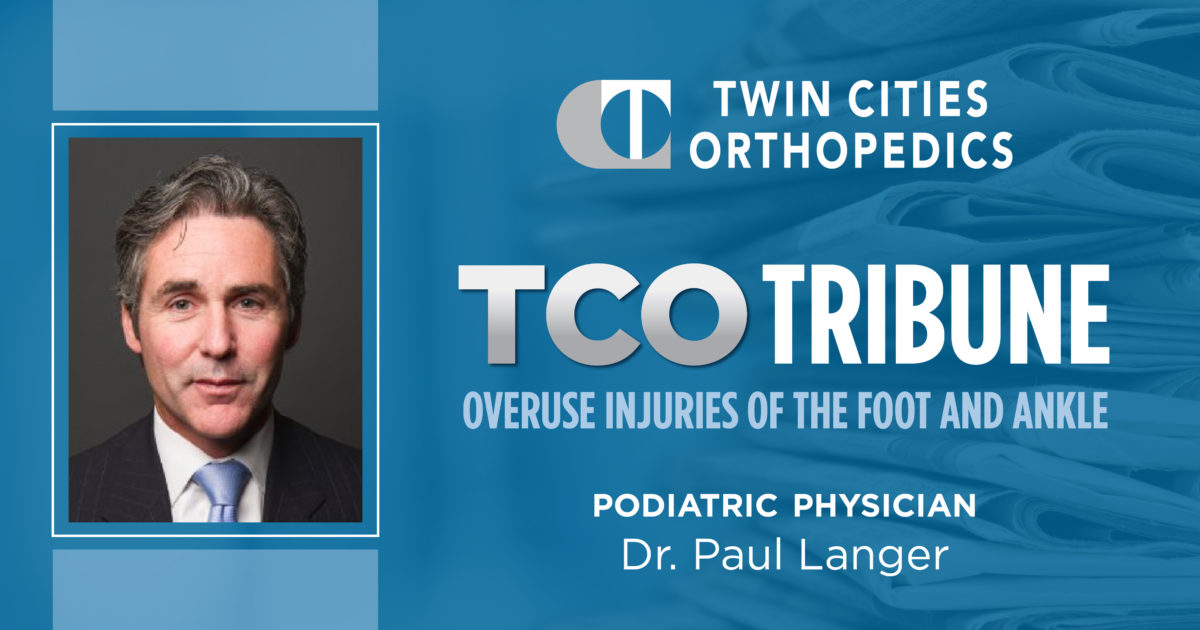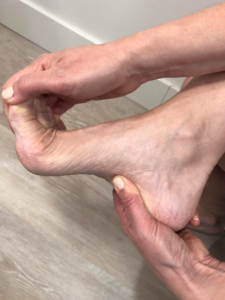
April 16, 2020 - TCO
Common Overuse Injuries of the Foot and Ankle
There has been a silver lining to the cloud of COVID-19 and the social distancing that has come along with it. While we are working from home and locked out of our health clubs, many of us now have more time to spend with family and time to devote to outdoor activities such as hiking, walking and running. Often, the whole family is doing these new activities together, and that is awesome!
Sometimes, however, our enthusiasm for this new-found freedom can exceed our body’s ability to keep up, and we may get injured. Fortunately, many injuries can be avoided or resolved quickly with some simple self-treatment methods. In the following article, we’ll discuss some general concepts regarding injury and then some of the most common foot and ankle injuries.
Getting Started
Our bodies are perfectly able to adapt to increases in stress and load such as a new (or increase in) workout activity as long as it is done incrementally, over time and with adequate time to recover. When beginning a new fitness activity, it should be balanced with less strenuous or complimentary activities and increased over weeks to allow the body to adapt.
For example, when starting a running program, it would be better to run every other day with the non-running days filled with biking, yoga or strength training. The body can recover from the increase in running even when doing another activity, and since other activities build strength and endurance in different ways, they will complement overall fitness.
Overuse Injuries
Most injuries related to walking or running are what are referred to as “overuse injuries.” Overuse injuries differ from acute injuries such as a sprained ankle, in that they start gradually and are rarely painful enough to stop activity early on, but gradually worsen or persist over time. In early stages of an overuse injury, there may be no pain at all during activity, but pain starts after the activity is over.
There is a high level of denial in active people who have the signs of an overuse injury, so they often continue their activity without addressing the pain. In later stages, the injury can progress to an acute injury that results in a long recovery period. A general rule of thumb with overuse injuries is that the longer they linger, the harder they are to get rid of, so recognizing the warning signs and responding quickly is important.
The Terrible Too’s
Research suggests that 60-90% of overuse injuries in runners are caused by training errors[i]. Sometimes, we call training errors the “Terrible Too’s,” too much, too soon and/or too little rest. Walkers and hikers are just as susceptible to the “Terrible Too’s” as runners.
Repetition is another risk factor for overuse injuries. Walking and running are highly repetitious. Walkers take approximately 1,000 steps per mile, landing with up to 1.5 times their bodyweight per foot step, while runners take 2,000 steps per mile, landing with up to 3 times their bodyweight. Other risk factors for injury include; age, body mass index, and previous injury history among others. Inadequate sleep and poor nutrition are also important factors in injury risk.
First Sign of Injury
At the first sign of injury it is important to assess the activity and other factors that may have contributed and address them.
- Was there a sudden increase in duration or intensity of an activity?
- Have sleep habits been adequate?
- Was there enough time to recover between workouts?
- Are there any non-sports activities that may have contributed, such as standing on a ladder painting for 2 hours before you went for a run?
Often the contributing factors are obvious, but sometimes they are not. Avoiding the activity that caused the injury is recommended, but keep in mind that it is okay to do other activities as long as they do not cause pain.
Symptomatic management can me initiated at the first sign of injury as well. Icing or taking NSAID’s or acetaminophen cannot heal an injury, but they can temporarily reduce pain and inflammation in the short term. Never ice for more than 30 minutes at a time and do not take more than the recommended dosage of medication. If a few days of symptomatic management and rest do not improve the pain, then seek medical care.
Footwear Considerations
While shoes are not the most likely culprit when an injury occurs, there are some aspects of footwear that cannot be overlooked in the context of injury. Shoes should be suitable for the activity and be in good shape. Starting a walking or running program with an old pair of basketball shoes would not be a good idea. It sounds obvious, but shoes should also be comfortable and fit properly.
Research shows that we use less energy, are less likely to sustain an injury or fall, and perform better in sports and fitness activities when wearing comfortable shoes[ii]. Conversely, a research review paper showed that not only are up to 72% of people wearing poorly fitting shoes, but that improper fit was associated with foot pain[iii]. Most of the subjects in the study were wearing shoes that were too narrow, too short or both. Comfortable footwear is also important in helping us recover from strenuous activity, foot pain or injuries.
4 Common Causes of Foot and Ankle Pain
- Plantar Fasciitis
The plantar fascia is a ligament that originates at the bottom of the calcaneus (heel bone) and extends to the bases of the phalangeal bones of the toes. It is the most important non-muscular soft tissue structure that supports and stabilizes the arch.
Plantar fasciitis is one of the most common causes of foot pain. It develops as overloading, inflammation and eventually degeneration of the plantar fascia. Pain is typically localized to the heel and may radiate into the arch. Most people report pain when arising from bed or after being seated. Pain often decreases gradually with activity in early stages, but may persist during activity in later stages.
Risk factors for plantar fasciitis include:
- Body Mass Index over 30
- Limited ankle range-of motion
- Increasing activity
- Jobs that require long periods of weight bearing activity and improper footwear
Fortunately, 80-90% of people can resolve their symptoms by doing some exercises and temporarily supporting the arch[iv] [v].
Strengthening exercises of the small muscles of the feet, as well as the large muscles of the lower leg (especially the calf and Achilles tendon), can be beneficial. A targeted stretch and myofascial release has been shown to relieve pain as well. Gently pulling back on the toes to create tension on the plantar fascia, then massaging with the opposite hand along the plantar fascia band, was shown to reduce pain in one study[vi].
Ten seconds per stretch, repeated ten times per set and 3 sets per day, reduced pain for 70% of subjects.
Plantar fascia stretch/massage

Supporting the arch with a firm insole can relieve strain on the plantar fascia by 25-35% which can help to reduce pain and allow for activity [vii]. There are a number of insoles available at footwear retailers that are suitable for managing plantar fasciitis. It is important to understand that insoles that are firm relieve strain on the plantar fascia better than cushioned insoles or heel cups. Insoles should be tried on and used in activity and selected based on comfort just as shoes are.
- Bone Stress Injuries (BSI)
Each of our feet have 26 bones, and along with the tibia and fibula of the lower leg, these bones are subjected to the high repetition and loading of walking and running gait that can approach 3 times bodyweight on every step.
BSI are sneaky injuries because they start very gradually and can progress to a fracture with sometimes little warning. An end-stage BSI is called a stress fracture. Bone stress injuries can affect any bone, but are more common in the bones of the lower legs and feet in walkers and especially runners.
Risk factors include:
- Training errors
- Metabolic bone disorders
- Poor nutrition
- Improper footwear
Pain often starts as a generalized ache, but then progresses to a more focal and acute pain with swelling and inability to bear weight. The metatarsals, which are the long bones of the feet, are a common site of pain with increased activity. Mild pain of the metatarsals is called metatarsalgia and may improve with a modification to the shoe called a metatarsal pad.
For more significant pain, rest from the activity that initiated pain. Sometimes immobilization in a fracture boot or crutches is necessary for healing. At the onset of acute pain and/or swelling, weight bearing activity should be minimized or discontinued immediately. Suspected BSI’s should be evaluated in a clinical setting with X-rays if they are too painful to walk on or do not respond to rest, symptomatic management and footwear within days.
- Achilles Tendinopathy
The Achilles tendon is the largest tendon in the body and transfers much of the power from our large leg muscles into our foot on every step. Achilles Tendinopathy can cause pain to the back of the heel, or just above the heel in the tendon substance. As with plantar fasciitis, in the early stages, pain may be minimal with activity but worse after sleeping or sitting, but can progress to the point of swelling and acute unrelenting pain.
An important exercise that has been utilized to treat Achilles Tendinopathy is often referred to as an eccentric loading exercise or the Alfredson Protocol for Achilles Tendinopathy[i] [ii]. A heel raise is done with the uninjured leg, then the injured leg is used to slowly lower until the foot is flat on the floor. Three sets of 15 repetitions daily are recommended as a starting point. Some variations of the protocol recommend additional sets and/or using weights to increase load.
- Great Toe Joint Pain
There are 33 joints in each foot, but the joint that is most vulnerable to pain and arthritis is the great toe joint. Altered alignment, boney prominence and stiffness of this joint can contribute to pain not only from activity, but also from shoes. X-rays are necessary to diagnose the cause of the pain, which can also include gout or sesamoiditis, but in early stages of bunions or arthritis, footwear changes can help minimize pain and allow for activity.
Bunions may be less painful with wider shoes to relieve pressure on the boney prominence. If arthritis is the source of the pain, footwear changes can be helpful. In fact, one study showed that 67% of those with arthritis of the great toe joint had less pain by either using a forefoot rocker shoe or an insole [iii]. There are a number of walking and running shoes now available which have forefoot rockers. More advanced bunions and arthritis may require surgical intervention.
Final Thoughts
Regardless of what type of pain you have, if your pain does not improve with 1-2 weeks of self-treatment or if you notice swelling, redness, bruising and/or pain that causes limping, stop the activity that provoked it immediately and seek medical care.
- Make sure to avoid the “Terrible Too’s”
- Allow your body to adapt to the increase in activity over time
[i] Alfredson H. The chronic painful Achilles and patellar tendon: research on basic biology and treatment. Scand J Med Sci Sports. 2005;15:252-9.
[ii] New regimen for eccentric calf-muscle training in patients with chronic insertional Achilles tendinopathy: results of a pilot study P Jonsson,1 H Alfredson,1 K Sunding,2 M Fahlstro¨m,3 J Cook4 Br J Sports Med 2008;42:746–749. doi:10.1136/bjsm.2007.039545
[iii] Menz, Hylton B., Maria Auhl, Jade M. Tan, Pazit Levinger, Edward Roddy, and Shannon E. Munteanu. “Effectiveness of Foot Orthoses Versus Rocker?Sole Footwear for First Metatarsophalangeal Joint Osteoarthritis: Randomized Trial.” Arthritis care & research 68, no. 5 (2016): 581-589.

